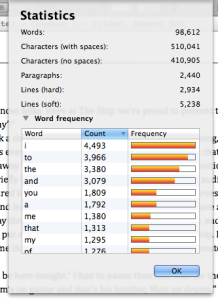 As I approach the end of my path to publication, money has started to occupy my mind quite a lot. Having made the decision to self-publish my first novel, I have obviously had to think long and hard about how much it’s all going to cost me and the dilemma I have had to face is how to publish the best piece of work I can whilst having no real budget to speak of. I have read enough ebooks to know that many self-publishers just aren’t thinking about quality at all before they hit the publish button or maybe they were but they just didn’t have the money to spend on quality control before publishing their first book. Whilst I understand and sympathise with that situation, I could not do that myself but there is no doubt that it’s expensive and if, like me, you want to publish a high quality piece of writing, then you need to give some thought in advance to the potential costs involved.
As I approach the end of my path to publication, money has started to occupy my mind quite a lot. Having made the decision to self-publish my first novel, I have obviously had to think long and hard about how much it’s all going to cost me and the dilemma I have had to face is how to publish the best piece of work I can whilst having no real budget to speak of. I have read enough ebooks to know that many self-publishers just aren’t thinking about quality at all before they hit the publish button or maybe they were but they just didn’t have the money to spend on quality control before publishing their first book. Whilst I understand and sympathise with that situation, I could not do that myself but there is no doubt that it’s expensive and if, like me, you want to publish a high quality piece of writing, then you need to give some thought in advance to the potential costs involved.
1. Editing
It is generally agreed that if you want to end up with a high quality book, you will need to have it edited by a professional. I had my first professional edit done by the Romantic Novelists’ Association (RNA) as part of their New Writers’ Scheme (NWS). I was lucky enough to get on to the scheme which includes a read through of your work in progress by an author. My reader sent me a three page report and made comments on my manuscript too. This was invaluable advice at the time. This edit equates to the developmental edit I guess in the round of edits that you could decide to have done. It cost me £120 to join the NWS for the year. Prior to that, I had asked a number of close friends to beta read for me and I had also made friends with a writer who beta read it for me, all of which was done for free.
As a result of attending the RNA Conference, I made contact with a couple of other professional editors too. When I approached them about editing though, I realised that I just couldn’t afford to pay for their professional services which started from £400 upwards. I felt caught then because I knew I had to have a professional edit and of course I wanted to pay people properly for their services but I couldn’t stretch to this. In the end, one of the editors was offering a special one-off deal of £90 and so, my problem was solved. In all, with some partial editing to my first three chapters, I have spent £150 on editing. With the fee to join the NWS added to that, this brings my total for editing to £270.
2. Cover Design
As you’ll know if you follow my blog posts every week, I have recently finished working with a cover designer for my novel. You can read the post here if you missed it. This service has cost me £187 but there will be a bit more (£50) when I go back for the print version of the cover. I know I could have spent less than this but I don’t think I would have ended up with a cover that I love as much as the one I have. I consider this to have been a very good investment and as you know, people do judge books by their covers and so it was important to me to get that right. Total cost then spent on cover design will be £237.
3. Proofreading
This past week, I have been looking into proofreading as the final step before publication. Once again, I knew that this was going to be a fair expense because I was going to need a professional. I have joined the UK Society for Editors and Proofreaders myself because I wanted to do their Introduction to Proofreading course and so I had an idea of what sort of cost to expect. Last week, I also took the plunge and joined the Alliance of Independent Authors and I was able to seek the advice of their members for recommendations which was very helpful. Still, it has been a difficult decision when all the people I’ve contacted have been equally well-qualified and professional in their response. They all have excellent references as well. So how you do you decide? In the end, I’ve reached a conclusion based on qualifications, availability, costs and personal recommendation. This is going to cost me around £250. I don’t think I could have paid less than this and still felt that I was going to get a professional service.
4. Everything else
This final section would include things like formatting, which I’m going to attempt myself with some help from my friends (!) and it might also include marketing. I have just run a giveaway on my Facebook Author page and it got me thinking about the promotional materials I might need to get before I launch my book. This would include postcards, bookmarks, business cards etc at the very least but I can’t really commit more than £100 to this.
In total then, for someone who has no budget, it looks like I will have spent about £850 to self-publish my book to a quality that I will be happy with. As these costs have mostly been staggered, I have managed it reasonably well. My understanding is that if I price my book at £1.99 on Amazon, I can expect to receive 70% royalties from them for every book I sell. By my calculations, that will mean that I will need to sell 610 books in order to make my money back. Now all I need to do is make it visible enough for readers to know it’s out there. And that will be a story for another blog post!
Thanks for reading as always. I welcome your comments about your experiences 🙂




